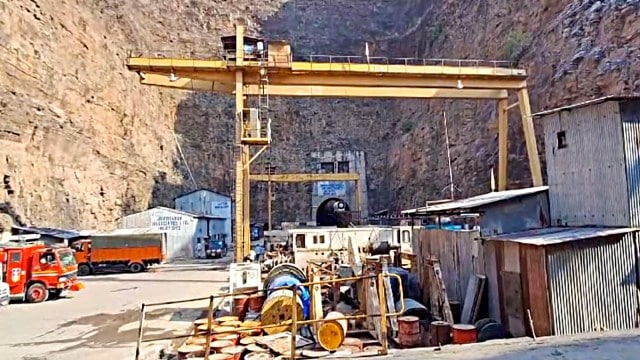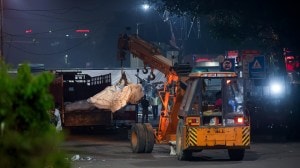Five days after eight workers were trapped inside a collapsed tunnel in Telangana’s Nagarkurnool district, the rescuers have begun cutting away the tunnel boring machine (TBM) that lies between the end rock where the men are stuck and the rest of the passage.

A portion of the Srisailam Left Bank Canal (SLBC) tunnel near Domalapenta collapsed on Saturday morning, trapping Project Engineer Manoj Kumar and Field Engineer Sri Niwas from Uttar Pradesh, workers Sandeep Sahu, Jagta Xess, Santosh Sahu and Anuj Sahu from Jharkhand, worker Sunny Singh from Jammu and Kashmir, and worker Gurpreet Singh from Punjab. On Wednesday evening, N Uttam Kumar Reddy, Irrigation Minister, had set a 48-hour deadline for the rescue operation.
Story continues below this ad
A senior government official said that the government has resolved to tackle all obstacles and bring out the trapped men. “Now, the decision has been taken to cut through the TBM. Earlier, this call was not taken due to the instability of the tunnel and soil. We will cut through the machine, and once the way is cleared, our men will go through the muck and debris to locate and rescue the trapped people. We are using all available resources at hand. This is the plan,” the official told indianexpress.com on Thursday.
“Another option is to explore alternate access to bypass this machine by circumventing it. Cutting through the machine will require less time than cutting through the rocks, which may be a tougher task,” the official added.
On Wednesday, Reddy had said that the team had assessed the situation thoroughly and devised clear strategies to minimise risk for the rescuers and move forward efficiently. “We now have a well-defined plan, and we are accelerating the rescue and relief operations with greater speed,” he said.
Reddy asserted that the rescue would be completed within two days and that new strategies were being implemented to mitigate challenges inside the tunnel. “Based on field inspections conducted over the last two days, we have made key decisions, and we are now going ahead with them. We are also exploring alternate access routes, including approaching from the side and the main exit, to expedite the rescue,” he added.
Story continues below this ad
According to Reddy, one of the biggest challenges in the rescue effort has been the massive accumulation of muddy water obstructing access to the TBM. To tackle this, the state government has intensified dewatering operations using advanced machinery, ensuring water removal progresses rapidly.
“We are taking additional precautions to ensure rescuer safety while moving forward aggressively to save the survivors,” Reddy said. He further emphasised that real-time monitoring of tunnel conditions was being carried out using advanced imaging systems. Experts continuously assessed the structural stability of the tunnel, ensuring that rescue teams could proceed safely without any risks to either the trapped workers or the responders.
On Wednesday, the Indian Marine Commando Force (MARCOS) Naval Commandos and the Border Roads Organisation (BRO) joined the rescue operation led by the National Disaster Response Force and other agencies such as the Army, Navy, State Disaster Response Force, National Highways and Infrastructure Development Corporation Limited and others.
As part of the intensified rescue operations, the government has also introduced reinforced support structures to stabilise the pathway leading to the TBM, ensuring that rescuers can navigate safely through the tunnel. Officials have been instructed to accelerate debris removal and reinforce weakened tunnel sections to prevent any secondary collapses. Remote-controlled devices, high-tech imaging systems, and precision excavation equipment were being deployed to assess the tunnel’s internal conditions with greater accuracy.









